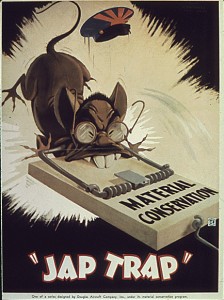
“Jap Trap,” World War II propaganda poster, United States Information Service, 1941–45. Densho Digital Archive, http://www.densho.org/.
“Propaganda can tip the scales,” claims Schivelbusch in regards to state influence in times of political turmoil in his Three New Deals. (85) The usual dialogue on the topic of interwar propaganda mostly elicits imagery associated with the USSR and Nazi regime, but what about the propaganda and control by the United States government? This is an example:
This blatantly racist imagery not only compares the Japanese to rats, it also depicts the rat with the physical stereotypes American’s gave the Japanese during the time. The squinted eyes, protruding teeth, and cartoonishly animated circular spectacles reappeared throughout anti-Japanese propaganda. The simple process of dehumanization of the enemy through animation also appears commonly in the anti-semitic propaganda perpetuated by the Nazis.
The Nazis as well as America assimilated the rat with their enemies. Rats are grotesque, parasitic, and carry disease. Essentially, they are an animal no one loves. It is certainly easier to identify propaganda that is new or foreign, however, after those images are presented repeatedly they become automatically associated with the intended concept and sink into the subconscious. This, in effect, is what makes it so powerful.
If an audience is being persuaded without realizing, can they stop it?


I think that it is very difficult for an audience to stop something that they don’t realize is happening. If an audience doesn’t see these ads and movements as propaganda, they often perhaps aren’t associating these initiatives with anything negative. Schivelbusch mentioned in his book a quote by Harold D. Lasswell, a author of a 1930s study on enforced conformity. Lasswell noted, “The spread of controversial issues is propaganda; the spread of accepted attitudes is skills education,” ((Wolfgang Schivelbusch, Three New Deals (New York: Picador, 2006), 74)) demonstrating that the line between propaganda and education is very easily blurred.
It is very difficult to determine whether or not the target audience that is being persuaded by propaganda can be stopped since they don’t even realize what is happening and what how their support for such propaganda affects the population that is being dehumanized. Schivelbusch states, “Propaganda is the means by which charismatic leadership, circumventing intermediary social and political institutions like parliaments, parties and interest groups, gains direct hold upon the masses” (Wolfgang Schivelbusch, Three New Deals (New York: Picador, 2006), 73). Propaganda is simply a tool that use to further assert the power of the regime and its leaders. Schivelbusch’s definition of propaganda demonstrates its effectiveness under these different governments because of their charismatic leaders and the sense of devotion towards the leaders and the state. Therefore, it is very difficult for an audience to stop something that they don’t realize is happening, especially when the same audience is blinded by the need to serve their country and be “good citizens.”